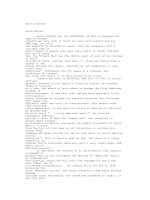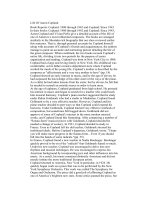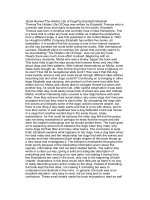life of aaron copland
Bạn đang xem bản rút gọn của tài liệu. Xem và tải ngay bản đầy đủ của tài liệu tại đây (46.49 KB, 4 trang )
Life Of Aaron Copland
Book Reports: Copland: 1900 through 1942 and Copland: Since 1943
In their books: Copland: 1900 through 1942 and Copland: Since 1943,
Aaron Copland and Vivian Perlis give a detailed account of the life of
one of America’s most influential composers. The books are arranged
similarly to the Shostakovich biography that our class reviewed earlier
this semester. That is, through personal accounts by Copland himself
along with accounts of Copland’s friends and acquaintances, the authors
manage to paint an accurate and interesting picture detailing the life of
the great composer. When combined, the two books recount Copland’s
entire life, dividing it into two periods for the purpose of easier
organization and reading. Copland was born in New York City in 1900.
Copland had a large and loving family in New York. His childhood was
comfortable, as his father owned a department store where Copland
worked for much of his young life. Copland’s mother is described by the
composer as "affectionate and a very nice mother to have" (pp. 18)
Copland showed an early interest in music, and by the age of eleven, he
had surpassed the knowledge of his older sister in the ways of the piano.
As a child, he had taken lessons from his sister, but by eleven, he felt that
he needed to consult an outside source in order to learn more.
At the age of eighteen, Copland graduated from high school. He pursued
his interest in music and began to search for a teacher who could teach
him musical harmony. Copland’s piano teacher suggested that he study
under Rubin Goldmark who had a studio in Manhattan. Copland found
Goldmark to be a very effective teacher. However, Copland and his
piano teacher decided to part ways so that Copland could expand his
horizons. Under Goldmark, Copland learned very effective methods of
composition, but sometimes felt bogged down. Goldmark did not
approve of some of Copland’s interest in the more modern musical
works, and Copland found this frustrating. After composing a number of
"Sonata-form" musical pieces with Goldmark, Copland decided he
needed a change of scenery. In 1921, Copland decided to study in
France. Even as Copland left his old teacher, Goldmark stressed his
traditional ideals. Before Copland’s departure, Goldmark wrote: "I hope
you will make more progress in the Sonata form…Even if you should
fall into the hands of some radicals."(pp. 35)
In France, Copland found a new teacher in Nadia Boulanger. Boulanger
quickly proved to be on of the "radicals" that Goldmark feared so much.
Under his new teacher, Copland was encouraged to delve into new
rhythms and musical techniques. He was encouraged to express his
American background by incorporating jazz and other influences into his
music. As a result, his music remained distinctly American and did not
merely imitate the more traditional European artists.
Copland returned to America, New York in particular, in 1924. He
quickly began work on a piece that was to be performed by the New
York Symphony Orchestra. This work was called The Symphony for
Organ and Orchestra. The piece did a good job of affirming Copland as
one of America’s brightest new stars. Some critics panned the piece, but
most enjoyed its originality. In fact, the work was even called "the voice
of America" (pp. 104). This can no doubt be attributed to the large
influence of jazz on Copland’s music. This influence gave Copland’s
music an American sound that differed from the more traditional works
of classical composers. Copland followed this work with more
"American" compositions that the composer played throughout the
country, and even in South America. As many composers do, Copland
found himself constantly searching for a steady income. At this time in
his life, Copland thought it would be best to slow down a little bit and
gather himself. He was offered a position teaching at the New School for
Social Research. Although the money was not extraordinary, the steady
income proved to be just what the composer was looking for. Not only
was Copland able to rest and make money, but this period of his life
allowed him to focus on the future of his music. He studied and taught
other types of more modern musical pieces and learned as much as he
taught. Copland also did a lot of musical promoting at this time. The
book devotes an entire section to an number of concerts Copland
organized with Roger Sessions. Along with these concerts in New York,
Copland sponsored a number of other concerts that greatly solidified the
worldwide respect for American music. Although American music was
being praised at this time, Copland expressed his distress at the influence
of musical critics. After the Yaddo Music Festival in 1932, Copland said:
"Frankly, I am consider daily newspaper criticism a menace, and we
would be better off without it." (pp. 206) During these years, Copland
also felt great influence from Russian neoclassical composers.
Specifically mentioned is Igor Stravinsky. Between the years of
Copland’s 30th and 35th birthdays, Copland composed a number of
pieces that showed this influence. One such work is Short Symphony, of
which Copland says he is very fond. In fact, Copland calls the piece one
of his "neglected children". (pp. 212) He says that, to him, it means more
that pieces such as this receive less attention than some of his more
popular works. This is interesting to me given his known dislike of
critics. It seems to me that he views his work with a loving heart, and
prefers that it remain only to be enjoyed by himself and those willing to
listen with an open mind.
In the 1930’s Copland spent a good deal of time in Mexico. He wrote a
number of pieces that expressed the influences he had there. Although
Copland was distinctly American, he still managed to capture the spirit
of another country with his music. Although many Latin fans were
supportive of Copland’s departure from his normal musical composition,
many of the composers with whom Copland associated did not like the
change in Copland’s style. Copland’s refusal to succumb to such
criticism is not surprising. He had always done his own thing and made
the music he wanted to. Although his true calling was composing more
classical pieces, he also enjoyed the opportunity to reach a larger
audience by changing his style every now and again. His delve into more
popular music was criticized, but Copland found it to be extremely
insightful. He says that it gave him the chance to remember how to
incorporate such influences of grass roots music (such as jazz) into his
works. By the end of the 1930’s, Copland was returning to his American
roots. At this time, he composed what he calls his most well received
work. This work was Billy the Kid. This ballet incorporates many
elements of America while at the same time producing wonderful music
that advances American composition. Critics and audiences both loved
the piece, and Copland’s popularity grew. He was hired to score many
movies, including such classical works as Of Mice and Men and Our
Town. By the end of the first book, Copland: 1900 through 1942,
Copland had fortified himself as one of the leading voices in American
music, and as a result, he became a voice for American culture. Along
with other American composers, Copland gave America the opportunity
to show that Europe alone did not control the evolution of music,
whether classical or otherwise. By the beginning of the second book,
Copland’s place in history was already secure. At the beginning of
Copland and Perlis’ second book, the opportunity for Copland to score
another movie is discussed. As earlier stated, Copland had already been
able to examine grass roots musical influences of America and Mexico.
The movie, The North Star, gave Copland the chance to discover another
country’s culture. This time, it was Russia. Copland researched Russian
folk songs and cultural influences when working on his score. The score
from this movie received much critical acclaim and even won Copland
an Academy Award. Again, Copland had proven that he was a master at
expressing the culture of a country through works of musical
accomplishment. In 1944, Copland’s ballet, Appalachian Spring,
debuted. This ballet was one of Copland’s most celebrated works. The
New York Times called Copland a "natural" (pp. 46). Appalachian
Spring even won Copland a Pulitzer Prize. The ballet was written for a
specific ballet dancer of the time period. Appalachian Spring was about
pioneers in Pennsylvania celebrating the building of a new farmhouse.
The work was another testimony to Copland’s ability to project every
day American life into art. Around this same time period, Copland began
lecturing at Harvard. In 1951, he became the Norton Professor of Poetics
at Harvard University. His lectures were published as a work of poems.
Around this time, Copland’s mother passed away. In the book, Copland
discusses how he took his mother’s death and the way that her passing
influenced his music. As earlier discussed, Copland came from a very
close family, and news about a member’s death was bound to be taken
hard. Between 1946 and 1954, Copland produced a number of his
greatest works. The Twelve Poems of Emily Dickinson and Copland’s
Third Symphony were both called Copland’s greatest individual work by
a number of Copland’s contemporaries. At this time in Copland’s life, he
traveled the world very much. After reading of all of the places he had
been, I began to wonder whether he viewed himself as an anthropologist
as well as a composer. In addition to composing Mexican and Russian
pieces during his life, Copland also traveled to Italy, Paris, and Israel,
learning about cultures and teaching people about music. Copland
performed and gave speeches while in foreign lands. He spoke both of
American culture and of music while he traveled the world.
Towards the end of Copland’s life, he again changed the way he viewed
music. In his fifties, Copland began conducting. He also began to
become more interested in a different style of composition. Namely, he
began composing in a 12-tone technique. I am not a skilled musician,
and I do not completely understand what this means, however, Copland’s
contemporaries found it to be a confusing and difficult style. He
composed a number of works in this format. In 1962 he composed
Connotations, and in 1967, he composed Inscape. These two pieces are
representative of his more mature style. Copland states in the second
book that he did not like being called a twelve tone composer, and felt
that he was a little bit misunderstood. He seems to have always felt that
just because he chose to explore a certain type of music, he should not be
criticized for his curiosity or his change of pace. This theme is
concurrent through both of the texts, and reaffirms Copland’s frustration
with critics. Although our assignment was only to write reports on the
two books by Copland and Perlis, I decided to do a little bit of research
about Copland’s accomplishments. I found it very interesting that
throughout both books, the topic of Copland’s frustration and
disagreement with music critics kept coming up. After reading the books,
it became apparent to me that Copland was a very decorated musician
with many awards to his credit. Although not all of these awards are
detailed in the book, I still was curious to find out just how critically
acclaimed Copland was. I found that he was one of the most honored
cultural figures in American history. Throughout his career, Copland
won, among other awards, the Presidential Medal of Freedom, and
Academy Award, a Pulitzer Prize, and the Commander’s Cross from the
Republic of Germany. Copland was also a director or board member of a
number of influential musical organizations, such as the American Music
Center and the Koussevitzky Foundation. Copland also received an
honorary doctoral degree from over 40 universities. Also, a school of
music was established in his name at Queens College in New York City.
So, although Copland was uncomplimentary of music critics, I found it
very interesting that critics were so very fond of him. Finally, I will say
something of my own insight. I find that reading quotations from a
contemporary of the composer is a much more insightful way to learn
about the composer’s influence than reading the composer’s own
thoughts. Copland’s modesty in his thinking is obvious when compared
to the way other artists of the time period viewed him and how music
critics and music organizations revered him. In both of the books by
Copland and Perlis, some contemporaries disliked Copland’s works, and
some loved them, but it seemed that all respected him. To me, is quite
telling that Copland’s works were truly as influential and culturally
insightful as it is claimed in his biography.









